At a secret location in southern Taipei County is a warehouse full of religious artifacts dating from over the last 2,000 years and coming from numerous nations around the globe. In another building in Yungho (
The man behind the museum that will house these symbols of man's spiritual quest is Dharma Master Hsin Tao (
He had chosen not to erect yet another temple for prayers to the Bodhisattva Guanyin, nor a charitable hospital to care for the sick, the staple projects of religious organizations. Master Hsin Tao aimed instead to create a symbol of peace that transcends national, political and most of all, religious boundaries.

PHOTO: MARK CALTONHILL
Dressed in his robes of dark red and speaking in measured tones, Master Hsin Tao is a paragon of beatific calm. But he is no stranger to conflict.
Born into a farming family on the Myanmar side of the border with Yunnan Province, in China, Master Hsin Tao lost both parents during the Chinese Civil War and was subsequently drafted as a child soldier into the guerilla army fighting the Communists from bases in Myanmar. According to an English biography, Sowing Seeds of Love, he saw much during that time that profoundly affected his later life. In 1961, aged 13, he accompanied the defeated KMT army to Taiwan.
Hsin Tao's inner peace is the result of his rigorous practice of Zen Buddhism, which he sees as a means of breaking down barriers.
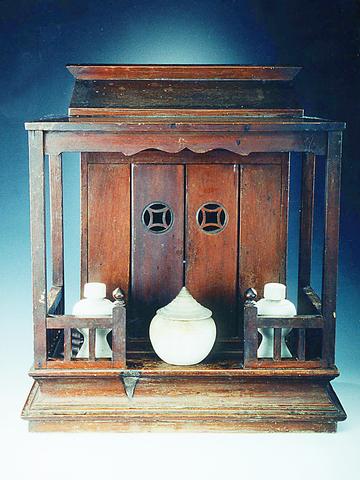
PHOTO: COURTESY OF MUSEUM OF WORLD RELIGIONS
His ambition is "respect for other's beliefs, tolerance of each other's cultures, and love for all of life." He believes that the museum of world religions is a step towards achieving this aim.
"Chan Buddhism (
Hsin Tao said, giving some insight into the manner his religious beliefs have led him to this current project.
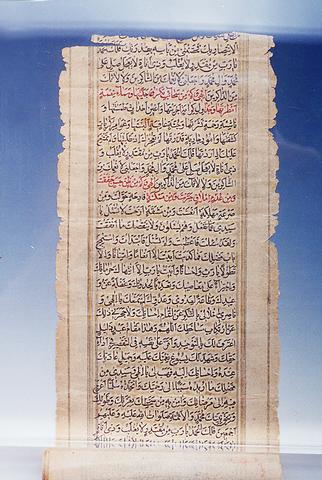
PHOTO: COURTESY OF MUSEUM OF WORLD RELIGIONS
In its conception, the museum was intended to be primarily religious and experiential, rather than a collection of antiquities. "Art and antiques can manifest religious wisdom. For the museum, we chose works that strongly move people or works relating to people who have made a great sacrifice or contribution to religion."
Inpiration and hard work
"Chan may help Master Hsin Tao and that's all well and good," said Robeca Hu (
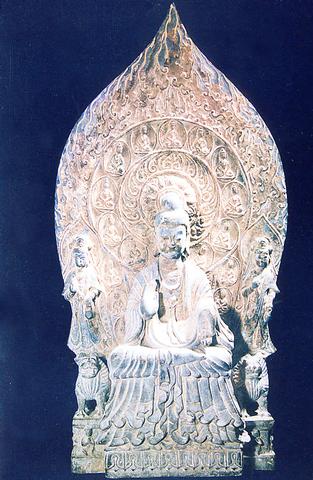
PHOTO: COURTESY OF MUSEUM OF WORLD RELIGIONS
Sullivan is the director of the Center for the Study of World Religions at Harvard, as well as associate editor of the Macmillan Encyclopedia of Religion and award-winning author of a series of religious books for children. He was enlisted to design the content of the museum.
"He drew up a list of some 350 key items to illustrate his texts which form the structure of the museum's exhibits, and my job has been to scour the planet for them. I can't tell you my annual budget but, while it might sound a lot, shopping at Christie's and other auction houses, or trying to pry private possessions from the hands of collectors is not cheap," Hu said. The total price tag when the museum opens in November is expected to be around NT$1.7 billion.
"Following Sullivan's advice, the museum now has twelve major displays: Buddhism, Daoism, Islam, Christianity, Hinduism, Judaism, Sikhism, Shinto, Taiwanese religions, sacred objects, ancient religions, and indigenous religions," Hu said. The last two are rotating exhibitions and, when the museum opens, will be represented by Egyptian deities and Mayan beliefs.
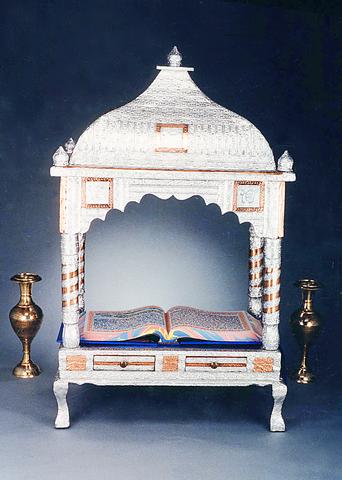
PHOTO: COURTESY OF MUSEUM OF WORLD RELIGIONS
With the scope of the museum expanded beyond its original conception, the need for expert advice became essential.
"After tracking down a suitable artifact, I find expert consultants and together we draw up a report. The final decision on purchase is made by the museum's CEO, Dharma Master Liao Yi (
Going global
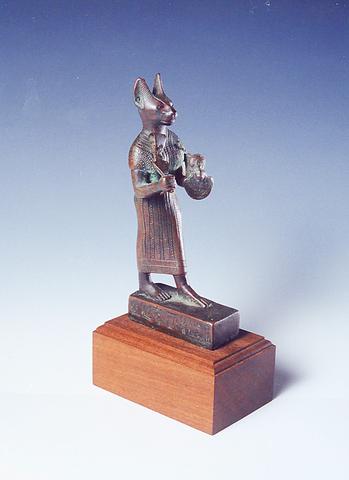
PHOTO: COURTESY OF MUSEUM OF WORLD RELIGIONS
The team of professionals at the museum includes people from a host of disciplines and different faiths: Buddhist, Taoist, Christian, Muslim, atheist and naturalist.
"I am spiritually moved in mountains and forests," explains Wang Chun-hwa (王春華), consultant project manager for the museum. "Although I couldn't be described as religious, the main reason I was attracted to work here was the museum's universal approach to religion."
Wang has overseen relations with Sullivan and Ralph Appelbaum Associates, the US company which designed the Holocaust Museum in Washington DC, and which was brought in as the project expanded. Wang also supervises the museum's collections.
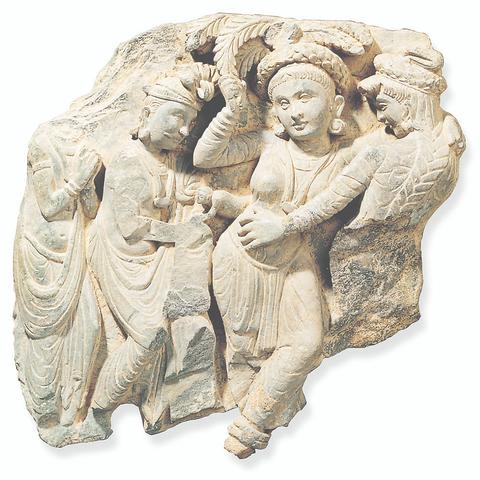
"There are three types of acquisition: purchases, donations and loans. While Hu has concentrated on the purchases and, as a religious leader, Master Hsin Tao is a frequent recipient of donations, I have assisted with the loans. Loans are important for rotating exhibits and enticing visitors back, but particularly necessary for the ancient and indigenous religions where we will change themes every two years," Wang said.
"With our own collection of 4,000 pieces representing East Asian religions, we can offer loans ourselves," Wang added.
Highlights of this collection include a third century sculpture from Pakistan depicting the Buddha's birth, an 11th century Hindu statue of the sun god, Surya, and a section of the Kiswah, the gigantic black curtain decorated with Arabic calligraphy embroidered in gold hung around the Ka'bah in Mecca, which was presented to the museum by the Muslim World League. Diplomatically, Master Hsin Tao refuses to be drawn on any personal favorites.
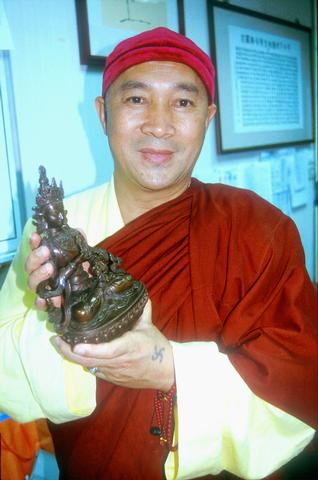
PHOTO: MARK CALTONHILL
Horng Moh-chour (洪莫愁), is the museum's curator with ultimate responsibility for making sure the museum's antiques are genuine.
"Actually, my field is Buddhist art; for other areas we employ consultants. While we do take every precaution, in a way it doesn't matter at the museum as one of the things we aim to stress is that these are living religions," Horng said.
"In addition to antiques and works of art, the museum is amassing a sizeable collection of contemporary items used in the practice of religious rituals," Horng said. "For these items, Master Hsin Tao and CEO Master Liao Yi travel the world making connections with other religious leaders who are usually more than happy to advise us on the practice of their own faiths."
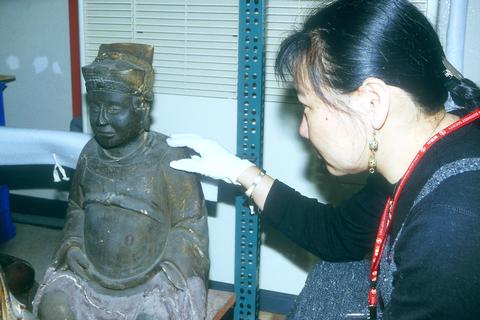
PHOTO: MARK CALTONHILL
Dharma Master Liao Yi became a Buddhist nun after graduating from Tamkang University. She was the third of Master Hsin Tao's disciples, who now number more than 100. As CEO, she is responsible for the museum's day-to-day operations including many decisions on acquisitions.
"The spirit of Chan Buddhism was the spark that started this process. Hopefully the museum and its contents will speak for themselves and for the religions they represent. Master Hsin Tao's dream is to encourage respect for difference faiths and use their points of unity to promote world peace and tolerance," Master Liao Yi said.
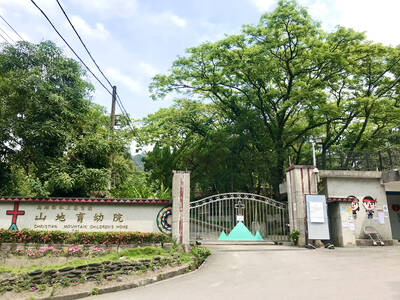
May 18 to May 24 Pastor Yang Hsu’s (楊煦) congregation was shocked upon seeing the land he chose to build his orphanage. It was surrounded by mountains on three sides, and the only way to access it was to cross a river by foot. The soil was poor due to runoff, and large rocks strewn across the plot prevented much from growing. In addition, there was no running water or electricity. But it was all Yang could afford. He and his Indigenous Atayal wife Lin Feng-ying (林鳳英) had already been caring for 24 orphans in their home, and they were in
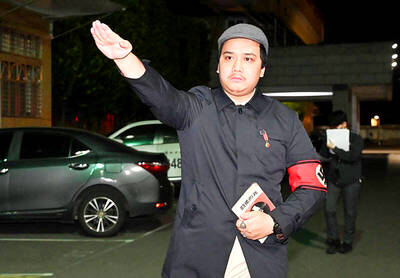
On May 2, Chinese Nationalist Party (KMT) Chairman Eric Chu (朱立倫), at a meeting in support of Taipei city councilors at party headquarters, compared President William Lai (賴清德) to Hitler. Chu claimed that unlike any other democracy worldwide in history, no other leader was rooting out opposing parties like Lai and the Democratic Progressive Party (DPP). That his statements are wildly inaccurate was not the point. It was a rallying cry, not a history lesson. This was intentional to provoke the international diplomatic community into a response, which was promptly provided. Both the German and Israeli offices issued statements on Facebook
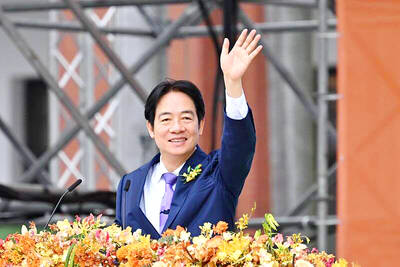
President William Lai (賴清德) yesterday delivered an address marking the first anniversary of his presidency. In the speech, Lai affirmed Taiwan’s global role in technology, trade and security. He announced economic and national security initiatives, and emphasized democratic values and cross-party cooperation. The following is the full text of his speech: Yesterday, outside of Beida Elementary School in New Taipei City’s Sanxia District (三峽), there was a major traffic accident that, sadly, claimed several lives and resulted in multiple injuries. The Executive Yuan immediately formed a task force, and last night I personally visited the victims in hospital. Central government agencies and the
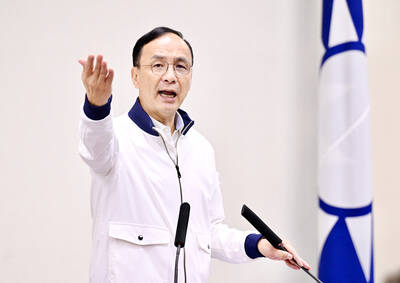
Australia’s ABC last week published a piece on the recall campaign. The article emphasized the divisions in Taiwanese society and blamed the recall for worsening them. It quotes a supporter of the Taiwan People’s Party (TPP) as saying “I’m 43 years old, born and raised here, and I’ve never seen the country this divided in my entire life.” Apparently, as an adult, she slept through the post-election violence in 2000 and 2004 by the Chinese Nationalist Party (KMT), the veiled coup threats by the military when Chen Shui-bian (陳水扁) became president, the 2006 Red Shirt protests against him ginned up by